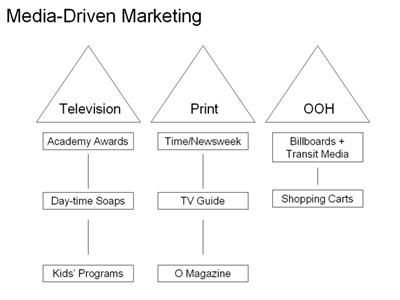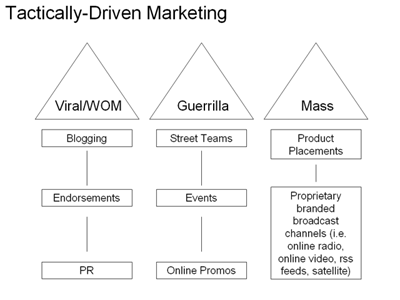|
|
By AL BERRIOS
Ratings down? Sales
collapsed? Marketing budget cut? Consider that in textbook (or, as we'll
call here, "classical") marketing, we're exhorted to arrange our
marketing efforts around media. Of course, then media converged (![]() 1),
but because textbook publishing is so lucrative (just reprint newer editions
with different page numbers, and presto! new text but no new investment
in content), publishers neglected to mention the sophistication of convergence
in their books. Anyway, with much of marketing predicated on (and even conflicting
with) the forms of media as the drivers of strategy, any bursts in new marketing
thinking stewed in back-office as "services" rather than leapt
to the forefront as drivers of marketing strategy.
1),
but because textbook publishing is so lucrative (just reprint newer editions
with different page numbers, and presto! new text but no new investment
in content), publishers neglected to mention the sophistication of convergence
in their books. Anyway, with much of marketing predicated on (and even conflicting
with) the forms of media as the drivers of strategy, any bursts in new marketing
thinking stewed in back-office as "services" rather than leapt
to the forefront as drivers of marketing strategy.
And marketing innovation being what it is, (a series of incrementally "edgy" tweaks based on nothing more than some other bloke's dumb luck at drawing awareness) marketing as a whole has few significant innovations (another unexpected outcome of increased accountability, where marketing execs now have the shortest shelf-life). And herein lies the opportunity - an innovation on marketing as a function, not merely the tools in its bag of tricks.
Let's be clear: customer relationship marketing, experience marketing, and all the other highfalutin names for repackaging old marketing tricks are steps in the right direction. But what the tactically-driven marketing organization should strive to achieve to truly innovate on their marketing is segregating all tricks into larger buckets by how those tactics function, rather than target audience or the more obsolete, media. Consider the following:
| Figure 1 | ||
 |
VS
|
 |
By appointing viral, guerrilla, and mass marketing czars (Figure 1), for example, the chief marketing officer can
1) manage investments in media in a superior way, since the name of the game isn't discounts on media for bulk buying, but targeted, planned investments;
2) more effectively reach audiences not by the ever-increasing media and content choices demanding their ever-decreasing time, but by involving your brands with the activities and transactions consumers ordinarily engage in during their typical day;
3) finally allow vendors and creatives the flexibility to explore the most effective operating structure for them, rather than forcing them into the industry-standard cookie-cutter operation, a structure which regrettably hinders them from offering clearer differentiation while also counter-intuitively increasing your cost of finding new providers, since you need consultants to help you differentiate and monitor your vendors and creatives;
4) shift performance discussions away from ratings, hits, and headcount and towards participation, transactions, and referrals as more relevant metrics of marketing's performance. This further disconnects marketing's role in sales from product quality, availability, and merchandizing, permitting a more fair debate over which executive really is doing the bulk of the work to increase the bottom line. And tangentially, is a great way of taking some power away from Nielsen.
Of Turfs and Budgets
It would not be a stretch to claim that too much of a marketing executive's time is committed to securing meetings, dollars, and credit. Consequently, after assembling a finely-tuned hierarchy (not necessarily a bureaucracy), it's abhorrent to rip it apart, appointing previously lower-ranking managers to key roles supervising formerly key executives and vendor relationships now demoted to lower importance.
Compounded with the way classical marketing tells us that each form of media, and budget, gets a dedicated executive to spend it, (which simultaneously indoctrinates all others to be careful not to step on that executive's toes), the suggestion that the current system should be revamped will assuredly cause deeper resentment by marketing executives not-yet-accustomed to being blamed for every bad thing that happens, who receive obtuse and conflicting objectives from superiors, and regrettably execute their plans like an episode of the Three Stooges.
A couple of years ago, a large media concern asked our firm to audit and compare their relationships with distributors and the relationships of their competitors with these same distributors. Our research uncovered that while they were concerned with getting more attention from established distributors via trade publications and knick-knacks smattered with their logo, their distributors were more concerned with new entrants into their business, a previously unexpected development. In fact, the change was so spectacular, that content ceased to be a significant driver of customer acquisition for these distributors; they went back to their roots and aggressively focused on the engineering behind their product offerings.
Consequently, our advice presented to them, a full-year ahead of their competitors, with a seemingly simple solution: cut back spending on your current marketing activities, and focus more on tailoring your own products and services to the way in which your distributors can best leverage it to fight their battles with their competitors. Besides immediate payoffs of 25% cost savings in spending online and other promotions, our client re-organized their departments to address the changed distributor landscape, rather than continue throwing good money at bad marketing.
Today, across the marketing spectrum, many companies continue to tweak their ideas of marketing in unguided attempts to do the same as our client: pairing back on marketing spending (i.e. GM's recent $600 million cut in their marketing budget) and re-organizing efforts to focus more on tactics that build word-of-mouth as opposed to splashy, all-media campaigns (i.e. AquaTeen Hunger Force). But because these changes are driven by impatient chiefs and boards, it's shortened the time in which marketing executives can deliver and leverage fresher ideas.
To continue (more smoothly) the ongoing transition to a tactically-driven marketing organization (without having to quit like Cartoon Network's president had to regrettably do after his support of AquaTeen's marketing antics), we advise
1) developing new parameters and benchmarks for execution that take into consideration a (genuine) collaboration with your colleagues over at research, merchandising, legal, procurement, and sales (nothing says innovative louder than changing the way in which you judge your performance from that industry norm; and nothing insulates marketing executives more than group efforts involving favored departments within the organization);
2) establishing a united and clear message for your brand from its various stewards, endorsed by the senior-most executive, who should also understand the significance of unison and clarity in branding (not just finance), so that accepting fresh ideas on progressing that brand message isn't a "moving-the-universe" type of endeavor (i.e. consider Wal-Mart's recent misunderstanding with the edgy Julie Roehm vs. Sandy Weil's 1998 support of a red umbrella for all Travelers/Citigroup brands);
3) altering your recruitment, expectations, and rewards (not always compensation) so as to identify professionals willing and empowered to inject new ideas on tactics, regardless of age or experience. (With your less-than-enthusiastic endorsement of ideas not your own, of course your subordinates aren't going to deliver. Just accept it - your job isn't to have all the ideas, but to find the people who will);
4) discouraging your agencies from patting themselves on the back for every single accomplishment, no matter how mediocre, then presenting it to you as a significant differentiator, and instead, allow you, their client, more influence in the determination of which agency truly effected change in your bottom-line strategies through their efforts, as is the case for almost every other service profession that celebrates its own accomplishments;
5) coming to terms
with the fact that it's not how much money you spend, but how much money
you make for the organization that is a surefire way to the corner office
of your choosing. And no other executive (other than sales) is better positioned
than marketers to realize this reality.
Footnotes
(1) Berrios, Al, "Convergence: Why Businesses Fail and How They Can Succeed", http://www.alberrios.com/c/0207media.html
Al Berrios is Managing Director of al berrios & co., a pure strategy consulting firm, specializing in advising organizations + entrepreneurs on managing their enterprises in a service economy. Write or Subscribe to Consumer Strategies Report.
|
|